If you are traveling to Italy in 2025, our research shows that you can stay connected with a Travel ...
Roami research
Traveling to France in 2025? You’ve got three main ways to stay connected: a Travel Pass for instant convenience, a Local SIM for unbeatable value, or an eSIM for fast, flexible setup before you even land. Each option has clear trade-offs, so let’s break down which works best for your trip.

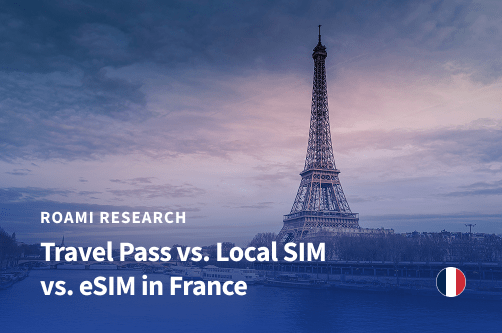
In 2025, staying connected in France isn’t a luxury. It’s how you find your way, book last-minute train tickets, share photos in real time, and keep in touch with home (or work) without missing a beat.
The options are straightforward, but each has its trade-offs:
So, what’s the smartest move for your trip to France? Let’s unpack the pros and cons so you can hit the ground running.
Knowing your “data personality” is the key to picking the right plan, because a weekend of light Instagramming and maps is very different from running Zoom calls out of Paris cafés.
Most travelers fall into two categories:
Here’s the reality check. A single hour on these apps can add up fast:
| App | 1 hour usage | What that means |
| Google Maps | 3–5 MB | Light usage, barely dents your plan |
| Spotify | 144 MB | Hours of music before data becomes an issue |
| YouTube | 1.5 GB | Just a few videos can burn through gigabytes fast |
| Netflix | 1 GB | One episode = nearly a full gigabyte |
| WhatsApp Video | ~900 MB | Long video calls add up quickly |
| Zoom | ~900 MB | A single call can use a day’s allowance |
| ~600 MB | Stories and reels quickly add up | |
| TikTok | 750 MB–1 GB | An evening scroll can eat multiple gigs in days |
| Google Drive Video | 300 MB (low quality) | Photo/video backups chip away steadily |
Let's make this real with two travelers who couldn't be more different:
Claire is a teacher from Seattle on her first solo trip to France. She's determined to be present, taking in every moment from the lavender fields of Provence to the châteaux of the Loire Valley. Her phone is a tool, not a crutch.
Claire's typical day:
Claire's daily total: ≈ 950 MB
Marcus is a travel blogger and digital marketing consultant who's working remotely while exploring France. His trip is both vacation and business, and staying connected isn't optional, it's how he pays for his adventures.
Marcus's power-user day:
Marcus's daily total: ≈ 3 GB
Now imagine both are planning a 10-day trip through France, from Paris to Nice, with stops in Lyon and Marseille. Their data needs tell completely different stories:
| Traveler type | Daily usage | 10-day trip total |
| Claire (light user) | 950 MB | 8-10 GB |
| Marcus (heavy user) | 3 GB | ~30 GB |
This difference is exactly why choosing the right connectivity option matters so much. Claire might save serious money with a budget-friendly plan, while Marcus needs unlimited data to avoid bill shock or slow speeds.
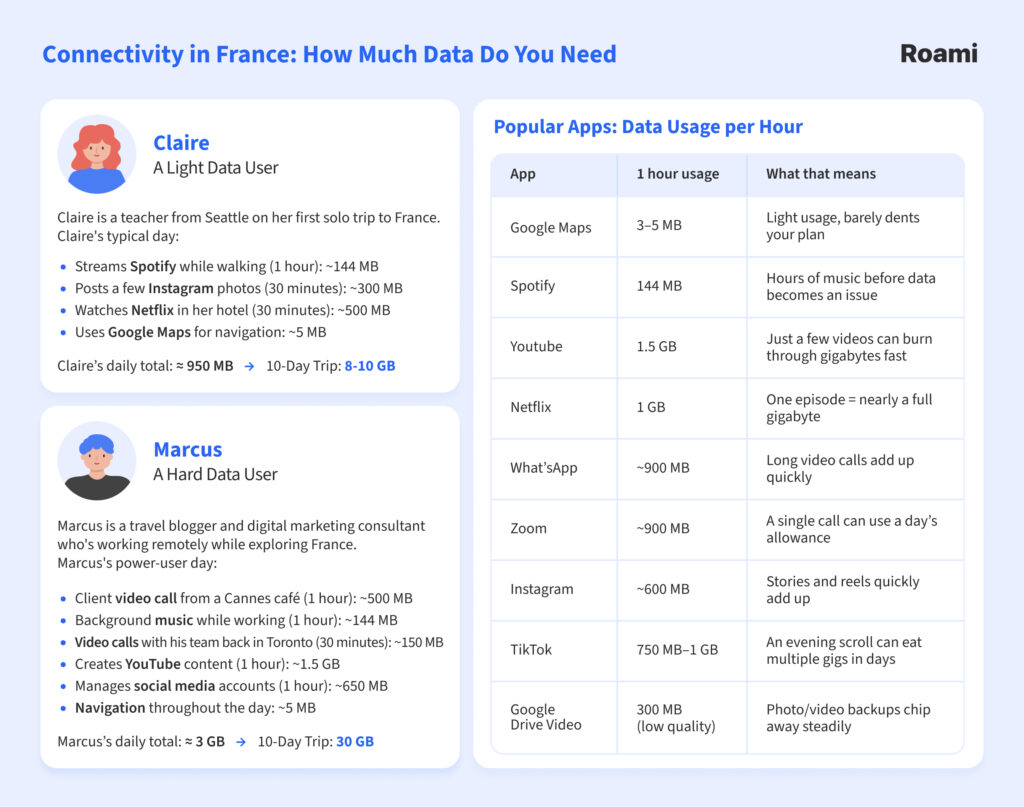
Now that you know which category you fall into, let's explore your three connectivity options in France and find your perfect match.
If you're traveling from the US with carriers like Verizon or AT&T, travel passes offer the ultimate in convenience. You literally flip a switch in your phone settings, and voilà, you're connected to French networks as if you never left home.
Let's look at what major US carriers actually offer for France in 2025:

| Plan | Daily data | Calls/texts | Price per day | 10-day cost |
| TravelPass | 5 GB (then 3G speed) | Unlimited | $12 | $120 |
| Monthly Plan | 20 GB total (then throttled) | 250 minutes, unlimited texts | ~$3.33 | $100 |
Claire fits neatly into Verizon’s International Monthly Plan. Her 8–10 GB total falls well below the 20 GB allowance, making it the cheaper and more sensible choice.
Marcus, on the other hand, would blow past that cap within days. For him, the TravelPass daily option offers more breathing room, but at $120 for 10 days, the costs climb fast.
The Verdict: Travel passes are the "first-class" option of mobile connectivity. Perfect for short business trips where you absolutely cannot risk being disconnected. But for longer stays the premium pricing quickly adds up.

French mobile carriers are among the most competitive in Europe, offering large data packages at surprisingly affordable prices. It’s not unusual to find plans with 100 GB or more for a fraction of what you’d spend on just a few days of international roaming.
The catch: getting set up usually requires an in-person visit to a mobile shop. You’ll need to bring your passport for registration, and depending on where you are, you may need to navigate some French-only paperwork or customer service.
Let's break down the major French carriers and their tourist-friendly options:
| Provider | Includes | Data | Validity | *Price |
| Orange France | Data + calls + SMS | 12-100 GB | 14-31 days | from €19.99 |
| SFR | Data + calls + SMS | 10-350 GB | 31 days | €4.99-€19.99 |
| Free Mobile | Data + calls + SMS | 350 GB (France) + 35 GB (EU/115+ destinations) | 31 days | €19.99 |
| Bouygues | Data + calls + SMS | 30 GB (France + 45 European countries) | 30 days | €29.90 |
*Prices are approximate and may vary by location and current promotions
The math is pretty compelling. Even Marcus, our heavy data user, could grab a 100 GB plan for around €20 total and have more data than he could possibly use. Claire would be swimming in excess data with any of these plans.
But after landing at CDG following a transatlantic flight, the last thing you might want to do is navigate French bureaucracy. Plus, bear in mind that sometimes it can take a couple of hours for your card to get activated.
For details on prices, where to buy, and the best tourist options, read our complete France SIM card guide.
The Verdict: Local SIM cards offer incredible value for money and are perfect if you're staying for weeks, need massive amounts of data, or enjoy a bit of adventure in your travel preparations. However, if you prefer to have everything sorted before you travel, the setup process might not be worth the savings.
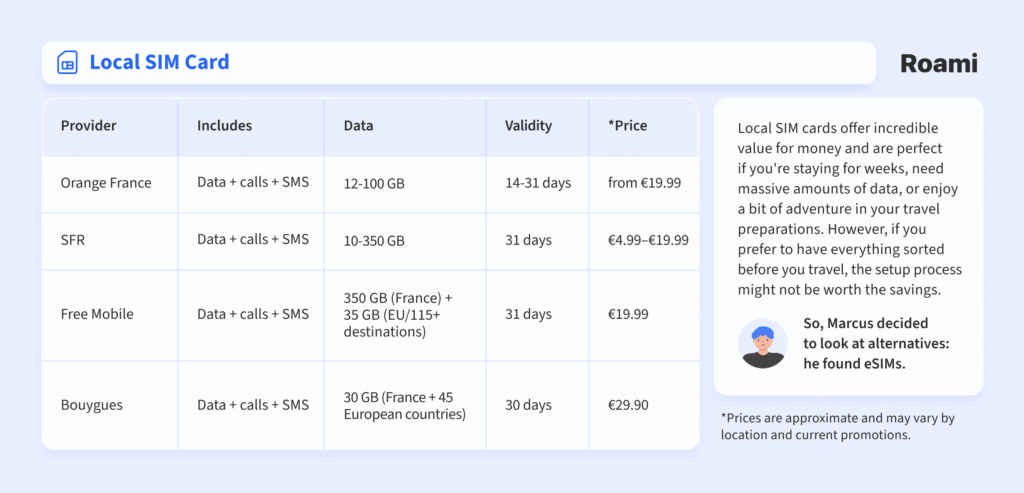
eSIMs represent everything modern travelers love: instant gratification, no physical hassles, and the ability to be connected before your plane even touches down in France.
An eSIM is essentially a digital SIM card that's built into your phone. Instead of fumbling with tiny plastic cards, you simply scan a QR code, and boom, you're connected to French networks.
You can buy your plan from your hotel in New York, activate it during your layover in London, and land in Paris already browsing French restaurant reviews.
Verdict: If staying connected in France without stress is your priority, eSIMs are hands-down the easiest solution. For heavy users like remote workers or creators, unlimited data providers such as Holafly remove the headache of monitoring gigabytes.
If you’re a light or budget-conscious traveler, Airalo offers low-cost, flexible packs that cover the basics. And if you want choice and reliability across multiple French networks, Nomad delivers the best of both worlds.
When picking an eSIM for France, three factors really matter: data allowance, price, and flexibility. Some travelers want the safety of unlimited data, others just need a few gigabytes to check maps and post updates, and some look for middle-ground options that balance value with coverage.
After reviewing the top providers, we narrowed it down to three that best cover the spectrum of traveler needs:
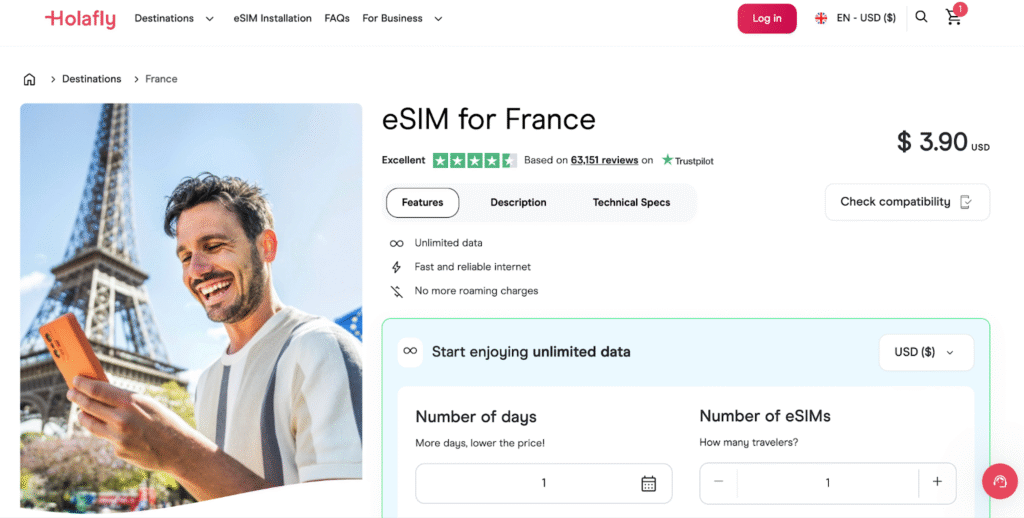
Holafly is one of the most popular choices for travelers who want unlimited data without hassle. Instead of juggling top-ups or tracking every gigabyte, you pay once, activate your eSIM, and enjoy reliable internet across France.
Plans start at around $3.90 per day, with flexible durations from 5 to 90 days. All options include unlimited 4G/5G data on Orange’s network, France’s largest provider.
For digital nomads, content creators, or anyone who doesn’t want to think about data limits, Holafly is a premium but convenient option.
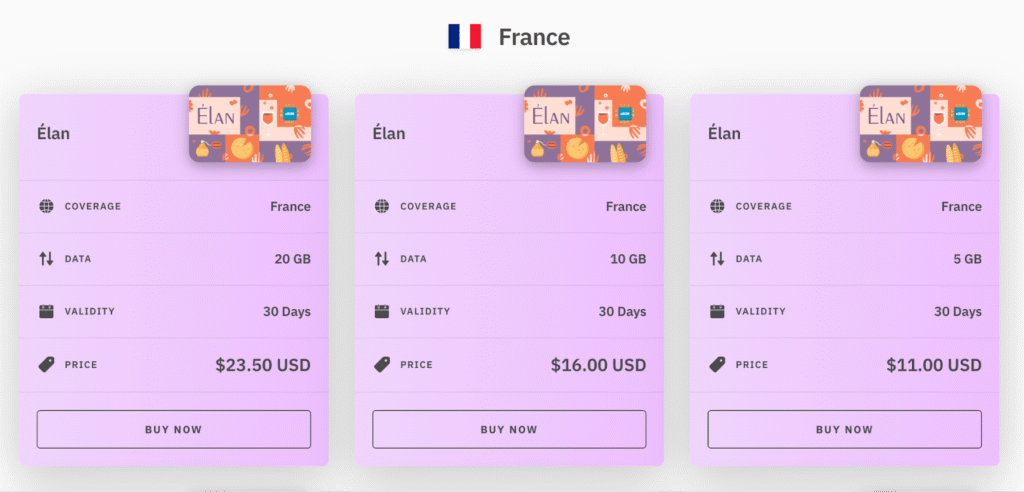
Airalo is one of the most affordable ways to get connected in France. Unlike Holafly’s unlimited plans, Airalo offers flexible prepaid data packages that you choose based on your needs.
The Élan plan for France runs on Orange’s network and starts at just $4.50 for 1 GB (7 days). Larger packs include 3 GB for $7 (30 days), 10 GB for $16 (30 days), or 20 GB for $23.50 (30 days).
Airalo is best for light or moderate users who want simple, low-cost connectivity without overpaying for unlimited data.
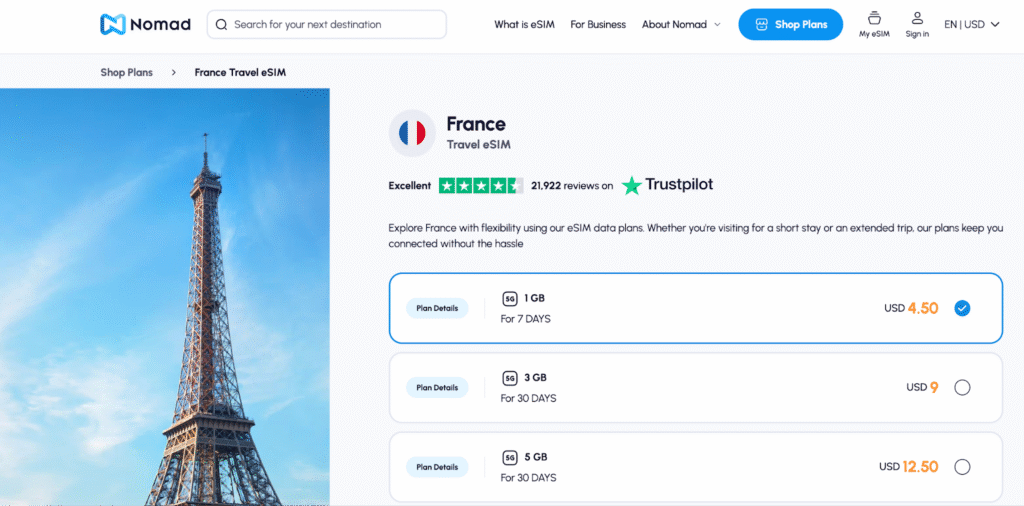
Nomad offers one of the most flexible ranges of prepaid eSIM plans for France. Travelers can choose between small data packs, large bundles, or even short-term unlimited options, making it easy to match your plan to the length of your stay.
Nomad eSIM connects to multiple French networks (including Bouygues, Free Mobile, Orange, and SFR) giving travelers flexibility and reliable 4G/5G coverage throughout the country.
For anyone who values choice, transparency, and multi-network access, Nomad is a strong alternative to Holafly’s unlimited model or Airalo’s budget packs.
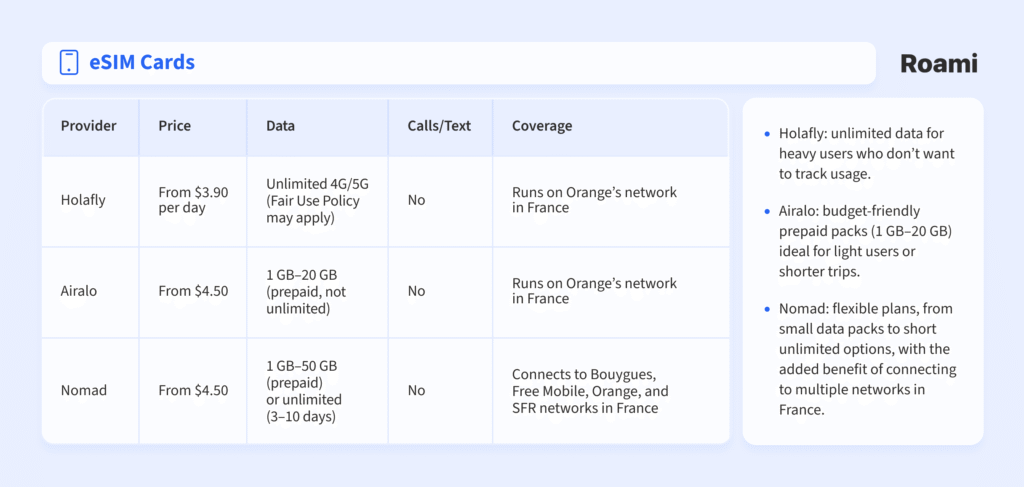
After diving deep into France's connectivity landscape, the choice really comes down to your travel style, budget, and data needs. There's no universally "right" answer, but there's definitely a right answer for you.
| Option | Data & price (2025) | Convenience | Calls & texts | Setup needed | Best for |
| Travel Pass | $12/day → 5 GB/day (then 3G) · $100/month → 20 GB | Very high (works instantly) | Yes, keep your own number | None (auto-activates) | Short trips, business travelers, zero setup tolerance |
| Local SIM | €5–30 → 10–350 GB (30 days) | Medium (must buy in France) | Yes (varies by provider) | Passport registration + SIM swap | Long stays, heavy data use, budget travelers |
| eSIM | Holafly: $3.90/day (unlimited) · Airalo/Nomad: from $4.50 (1 GB, 7 days) | High (activate with QR code) | Mostly data-only (use apps for calls) | Requires eSIM-compatible phone | Flexible users, digital nomads, no-hassle setup |
Choose a Travel Pass if you:
Choose a Local SIM if you:
Choose an eSIM if you:
Verdict: For most travelers, eSIMs are the sweet spot. They combine the instant convenience of a Travel Pass with pricing that often rivals Local SIMs (without the hassle of in-person setup). Heavy users will love Holafly’s unlimited plans, while budget-conscious travelers can stretch their euros with Airalo or Nomad.


